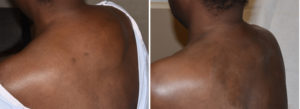Background: The accumulation of fatty tissue at the back of the neck is a well known side effect from certain HIV medications. One of these lipodystrophic sites is the cervicodorsal region where abnormal fat distributions can occur. Because of its raised area below the back of the head it has been given the moniker of a ‘buffalo hump’. Such disfigurements can be very distressing to those patients so affected.
The mainstay of treatment for such buffalo humps has been surgery. No non-surgical therapies have been shown to be effective. Excision lipectomy has been most commonly used and has good success rates in small clinical series. The most common complications have been a high rate of seromas and wound dehiscences. Such complications are usually self-resolving and have not required reoperations. Recurrent fat accumulations have also not been reported to occur.
Liposuction offers a treatment approach to the buffalo hump that does not involve an open excisional approach. This avoids the risk of wound dehiscence, significant visible scars and a very low rate of seroma formation. With the many different types of liposuction devices available today, improved reductions are possible compared to traditional suction-assisted lipectomy using standard cannulas.
Case Study: This 47 year-old male presented with a large and painful buffalo hump that had been growing for years. It had gotten big enough that it caused pain on neck extension and was also a source of embarrassment.


Cervicodorsal lipodystrophy, aka buffalo hump, is a well known complication of the extended use of HIV protease inhibitor drugs. Because of the fibrofatty composition of the buffalo hump tissue, it has been suggested that only excision can prevent its recurrence or be effective in removing it. This clinical directive is based on the use of traditional liposuction techniques and not on more contemporary liposuction technologies. Today’s energy or power-driven liposuction devices are far more effective at treating denser or scarred fat accumulation sites.
Highlights:
1) A buffalo hump deformity at the back of the neck is a well known sequelae of HIV protease inhibitor therapies.
2) While excision of buffalo hump deformities is effective it is associated with scars and seroma formation.
3) Liposuction of buffalo hump deformities is equally effective as open excision with a lower risk of complications.
Dr. Barry Eppley
Indianapolis, Indiana


